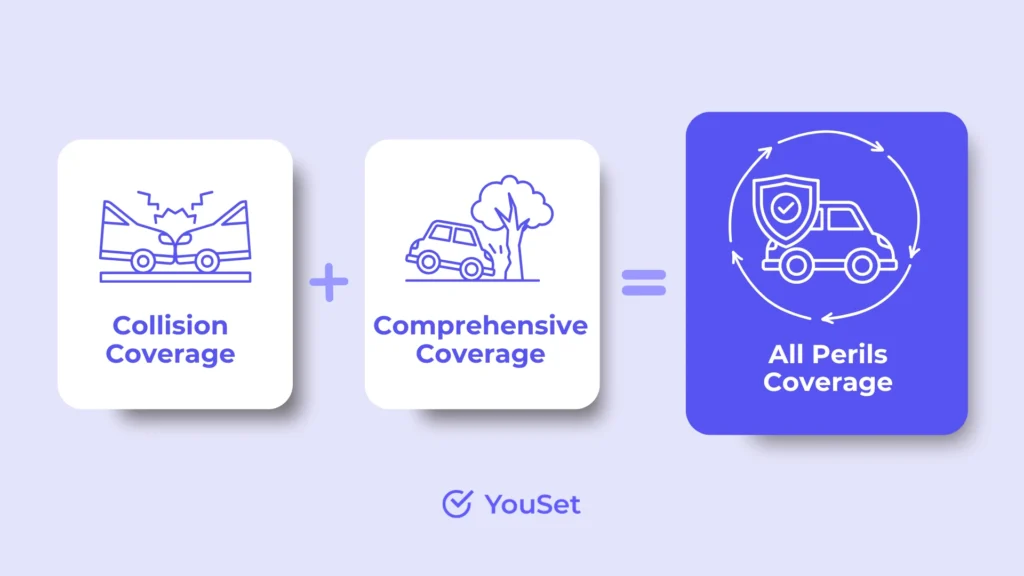Five years ago, the average price of a used car was $18,900. Today, that figure now sits at $35,754. Meanwhile, new cars, which averaged $45,255 in 2019, now cost an average of $66,979. That’s a significant investment, one that’s vulnerable to a wide range of risks, whether you’re on the road or parked “safely” in your driveway. Given the high stakes, protecting your vehicle makes sense, and one way to do that is with all perils coverage.
In this article, you’ll learn about what all perils coverage is, what it covers, and how it’s different from collision and comprehensive coverage. We’ll also provide a list of important questions to ask yourself so you can decide for yourself whether or not it’s actually worth it.

What is all perils coverage?
All perils coverage is an optional type of car insurance coverage that combines the benefits of collision and comprehensive coverage into one package. Essentially, its purpose is to protect your vehicle from the damage you can do to it and the risks posed by external factors that are outside your control such as theft, vandalism, and extreme weather.
As the most extensive type of coverage available in Canada, it generally comes with a higher price tag. However, the added cost is justified by some drivers for the peace of mind it provides, as it can help reduce out-of-pocket expenses for repairs or vehicle replacement following unexpected collisions or incidents.
That said, it’s important to note that “all perils” does not equate to unlimited coverage. Standard exclusions, such as wear and tear and intentional damage, apply to most policies. You may also find that not all insurance providers offer it; instead, they may opt to keep comprehensive and collision coverage separate so that you have greater flexibility to customize your policy.
What does all perils coverage cover?
All perils coverage combines the risks typically addressed separately by collision and comprehensive coverage, protecting you against a wide range of events that could damage or lead to the total loss of your vehicle. While the exact list may vary by insurer, all perils coverage generally covers everything offered by both, including:
- Collisions with another vehicle where you’re at fault
- Collisions with stationary objects such as guardrails, trees, or traffic lights
- Collisions involving road hazards like debris or potholes
- Collisions involving the ground, including driving into a ditch
- Hit-and-run accidents, covering damage when the at-fault driver cannot be identified
- Rollover accidents
- Damage caused by animals, such as hitting a deer or other wildlife
- Weather-related damage, such as hail and windstorms
- Vandalism, such as graffiti, keyed paint, slashed tires, or broken windows
- Theft, including stolen vehicles, stolen parts, and catalytic converter theft
- Falling objects, like tree branches, construction debris, or falling ice
- Fire, covering damage caused by vehicle fires or external sources
- Loss or damage caused by someone in your household
- Loss or damage caused by someone hired to drive your vehicle, such as a chauffeur or mechanic
All perils coverage vs. collision vs. comprehensive
The main difference between all perils, collision, and comprehensive coverage lies in the scope of protection they offer. Collision coverage covers collisions that you’re responsible for causing, while comprehensive coverage, on the other hand, addresses non-collision risks such as theft, vandalism, and extreme weather. Since all perils coverage combines collision and comprehensive coverage into one, it includes both collision-related damage and a wide range of non-collision incidents. You can see these differences clearly in the table below.
| Perils | Collision coverage | Comprehensive coverage | All perils coverage |
| Collisions with another vehicle | ✔️ | ✖️ | ✔️ |
| Collisions with stationary objects | ✔️ | ✖️ | ✔️ |
| Collisions with road hazards | ✔️ | ✖️ | ✔️ |
| Hit-and-run collisions | ✔️ | ✖️ | ✔️ |
| Rollover accidents | ✔️ | ✖️ | ✔️ |
| Weather damage | ✖️ | ✔️ | ✔️ |
| Vandalism | ✖️ | ✔️ | ✔️ |
| Theft | ✖️ | ✔️ | ✔️ |
| Fire | ✖️ | ✔️ | ✔️ |
| Falling objects | ✖️ | ✔️ | ✔️ |
| Animal damage | ✖️ | ✔️ | ✔️ |
Is all perils coverage worth it?
All perils coverage isn’t legally mandatory in Canada, so whether it’s worth it or not is entirely up to you. To help you make an informed choice, ask yourself the following questions. These will help you assess your driving habits, risk tolerance, and financial situation when considering if the added coverage is a good investment.
- Do you currently have collision and comprehensive coverage? Does your insurer offer all perils coverage? If so, what’s the price difference of switching to all perils coverage instead?
- How much is your vehicle worth? Could you financially manage to repair or replace it out of pocket without any assistance from car insurance?
- Is your car leased or financed? If so, does your lease or loan agreement require specific coverage?
- Can you afford to pay for repairs or a replacement vehicle out-of-pocket in case of an accident?
- How often do you drive? Do you typically encounter high-risk driving conditions such as heavy traffic or challenging weather?
- Are you a confident driver or do you often find yourself anxious or worried behind the wheel?
- How much peace of mind would all perils coverage give you in the event of theft, vandalism, or severe weather?
- Are you willing to pay a higher premium for broader protection?
- Does your insurer offer any discounts or benefits for bundling all perils coverage with other policies, like home insurance?




